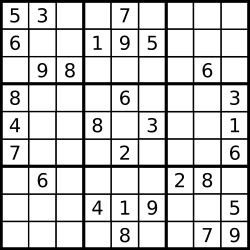Write a program to solve a Sudoku puzzle by filling the empty cells.
A sudoku solution must satisfy all of the following rules:
1-9 must occur exactly once in each row.1-9 must occur exactly once in each column.1-9 must occur exactly once in each of the 9 3x3 sub-boxes of the grid.The '.' character indicates empty cells.
Example 1:

Input: board = [["5","3",".",".","7",".",".",".","."],["6",".",".","1","9","5",".",".","."],[".","9","8",".",".",".",".","6","."],["8",".",".",".","6",".",".",".","3"],["4",".",".","8",".","3",".",".","1"],["7",".",".",".","2",".",".",".","6"],[".","6",".",".",".",".","2","8","."],[".",".",".","4","1","9",".",".","5"],[".",".",".",".","8",".",".","7","9"]] Output: [["5","3","4","6","7","8","9","1","2"],["6","7","2","1","9","5","3","4","8"],["1","9","8","3","4","2","5","6","7"],["8","5","9","7","6","1","4","2","3"],["4","2","6","8","5","3","7","9","1"],["7","1","3","9","2","4","8","5","6"],["9","6","1","5","3","7","2","8","4"],["2","8","7","4","1","9","6","3","5"],["3","4","5","2","8","6","1","7","9"]] Explanation: The input board is shown above and the only valid solution is shown below:
Constraints:
board.length == 9board[i].length == 9board[i][j] is a digit or '.'.The core challenge of solving a Sudoku puzzle lies in ensuring that each number from 1 to 9 appears exactly once in each row, column, and 3x3 sub-box. This problem is significant in various fields such as constraint satisfaction problems, artificial intelligence, and recreational mathematics. A common pitfall is not considering all constraints simultaneously, leading to invalid solutions.
To solve the Sudoku puzzle, we can use a backtracking algorithm. This approach involves trying to place a number in an empty cell, checking if it leads to a valid solution, and backtracking if it doesn't. Here's a step-by-step breakdown:
Here's a detailed breakdown of the backtracking algorithm:
def solve_sudoku(board):
def is_valid(board, row, col, num):
# Check if the number is not repeated in the current row, column, and 3x3 sub-box
for i in range(9):
if board[row][i] == num or board[i][col] == num:
return False
if board[3 * (row // 3) + i // 3][3 * (col // 3) + i % 3] == num:
return False
return True
def solve(board):
for row in range(9):
for col in range(9):
if board[row][col] == '.':
for num in '123456789':
if is_valid(board, row, col, num):
board[row][col] = num
if solve(board):
return True
board[row][col] = '.'
return False
return True
solve(board)
Here's the complete Python code to solve the Sudoku puzzle:
def solve_sudoku(board):
def is_valid(board, row, col, num):
# Check if the number is not repeated in the current row, column, and 3x3 sub-box
for i in range(9):
if board[row][i] == num or board[i][col] == num:
return False
if board[3 * (row // 3) + i // 3][3 * (col // 3) + i % 3] == num:
return False
return True
def solve(board):
for row in range(9):
for col in range(9):
if board[row][col] == '.':
for num in '123456789':
if is_valid(board, row, col, num):
board[row][col] = num
if solve(board):
return True
board[row][col] = '.'
return False
return True
solve(board)
The time complexity of the backtracking algorithm is O(9^(n*n)), where n is the size of the board (9 in this case). This is because, in the worst case, we might have to try all 9 numbers for each cell. The space complexity is O(n*n) due to the recursion stack.
Potential edge cases include:
Our algorithm handles these cases by ensuring that it checks all possible numbers for each empty cell and backtracks if necessary.
To test the solution comprehensively, we can use a variety of test cases:
We can use Python's unittest framework to automate the testing process.
When approaching such problems, it's essential to:
Solving a Sudoku puzzle using a backtracking algorithm is a classic example of constraint satisfaction problems. Understanding and implementing this algorithm helps in developing problem-solving skills and understanding the importance of considering all constraints simultaneously.
For further reading and practice problems, consider the following resources:
Our interactive tutorials and AI-assisted learning will help you master problem-solving skills and teach you the algorithms to know for coding interviews.
Start Coding for FREE